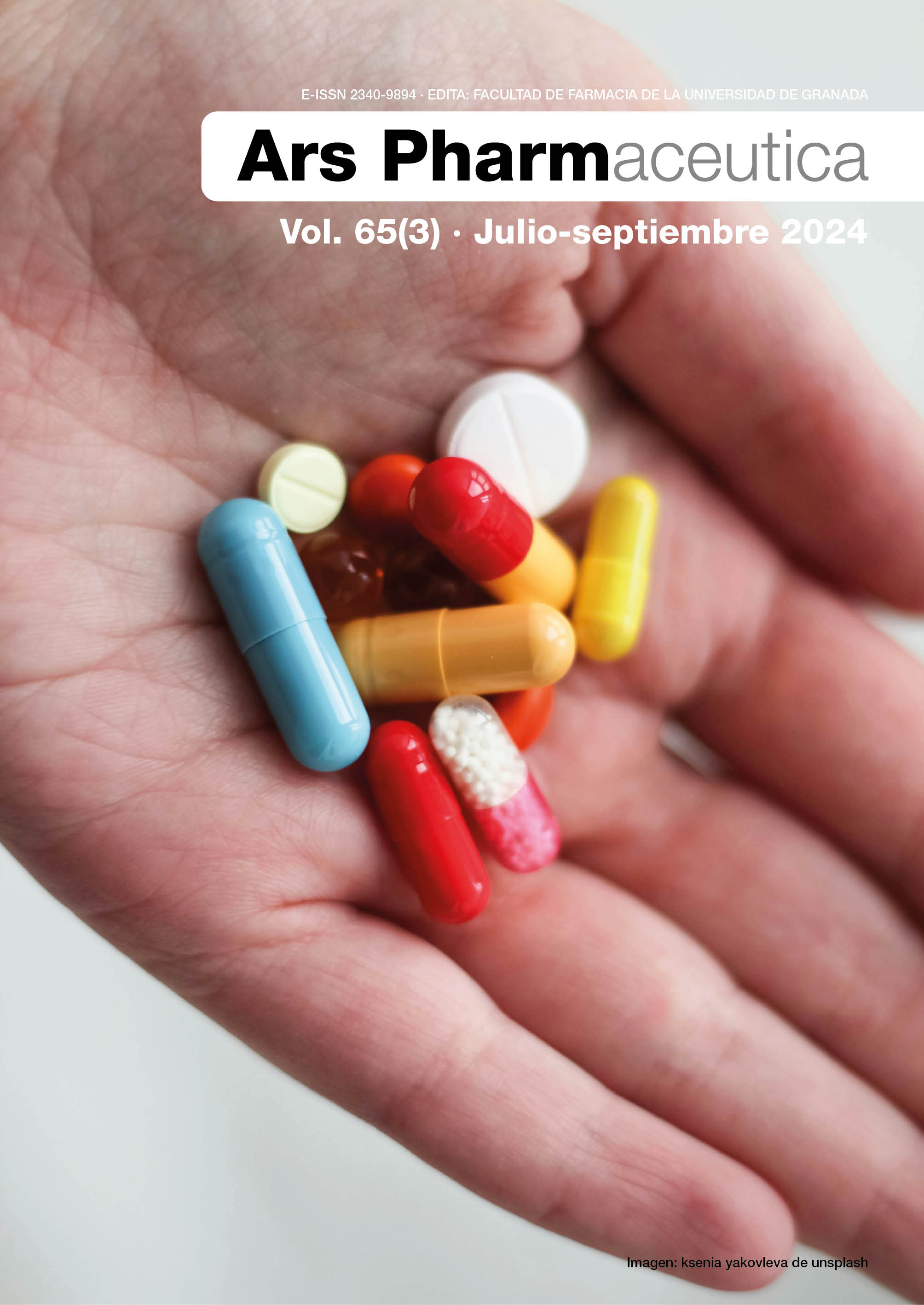Determinación mediante cromatografía líquida de alto rendimiento y colorimetría de los alcaloides de Hyoscyamus muticus L. subsp falezlez (Coss.) Maire en tres zonas de cosecha del Sahara argelino
DOI:
https://doi.org/10.30827/ars.v65i3.30517Keywords:
Hyoscyamine, Algeria, Hyoscyamus, HPLCAbstract
Introduction: Hyoscyamus muticus L. subsp falezlez (Coss.) Maire is a Saharan species rich in tropane alkaloids (especially hyoscyamine). Hyoscyamine is raced into atropine, whose interest in pharmacy is considerable.
The objective is to dose Hyoscyamus muticus L. subsp falezlez (Coss.) Maire alkaloids from the stations of Algerian Sahara (Abadla, Adrar, and Tamanrasset), to exploit the data in the valorization of this species as a potential source of industrial production of atropine.
Method: The determination of tropane alkaloids (Hyoscyamine and scopolamine) concerned the whole plant (spontaneous and cultivated) and the various organs and was carried out by colorimetric method and High-performance liquid chromatography (HPLC).
Results: The colorimetric assay showed that the highest level of alkaloids was observed in the Adrar Sbaa station (2.83 %) in the leaf organ. However, the stem organ showed an average level of alkaloids in all harvesting stations (from 0.5 to 0.98 %).
The HPLC assay confirmed the alkaloid and hyoscyamine richness in all study stations for spontaneous plant and cultivated species. The plant of the two stations (Tamanrasset and Adrar Sbaa) stood out with grades reaching (6.693±0.555 mg/100gDM and 4.707±0.092 mg/100gDM) respectively, and a hyoscyamine rate of (5.765± 0.23 mg/100gDM) for the Tamanrasset station.
Conclusions: At the end of our study and the content of the results obtained on Hyoscyamus muticus subsp falezlez (Coss.) Maire of Algeria, it is imperative to exploit this species as an industrial source of atropine production in Algeria.
Downloads
References
Süntar I. Importance of ethnopharmacological studies in drug discovery: role of medicinal plants. Phytochem Rev. 2020; 19 (5 ):1199-1209. DOI: https://doi.org/10.1007/s11101-019-09629-9
Strauss A. XVI Hyoscyamus spp.: In Vitro Culture and the Production of Tropane Alkaloids. Medicinal and Aromatic Plants II. Biotechnology in Agriculture and Forestry. Berlin: Springer; 2012. 286p. DOI: https://doi.org/10.1007/978-3-642-73617-9_16
Boukhalfa Dj.Contribution of the study of aromatic and medicinal plants of the Ahaggar region. [tesis doctoral], Algiers: Univ. Algeria; 2017.
Bruneton J, Poupon E. Pharmacognosy, phytochemistry, medicinal plants. Lavoisier. 5 ª ed; 2016.1166-1184. France.
Aniszewski T. Alkaloids-Secrets of Life:: Aklaloid Chemistry, Biological Significance, Applications and Ecological Role. Elsevier; 2007. 334p.
Hammiche V, Maiza K.. Traditional medicine in Central Sahara: pharmacopoeia of Tassili N’ajjer. ISE. 2006;105 (3): 358-367 DOI: https://doi.org/10.1016/j.jep.2005.11.028
Rey-Giraud G. Contribution to the chemical and toxicological study of solanaceae responsible for calls to the poison and toxicovigilance center of Toulouse [tesis doctoral]. Toulouse:Toulouse III-Paul Sabatier Univ. France; 2018.
Bahmanzadegan JA, Sefidkon F, Sonboli F. Determination of hyoscyamine and scopolamine in four Hyoscyamus species from Iran. IJPR. 2009; 8 (1): 65-70.
Paul R, Datta K. Animesh. An updated overview on Atropa belladonna L. IROP. 2011; 2 (11):11-17.
Goullé JP, Pépin G, Dumestre-Toulet V, Lacroix C, Botany, chemistry and toxicology of hallucinogenic solanaceae: belladonna, datura, henbane, mandrake. Ann Toxicol Anal. 2004; 16(1): 22-35. DOI: https://doi.org/10.1051/ata/2004023
Abdelazeez WMA, Anatolievna KY, Zavdetovna KL, Damirovna AG, Abou El-Dis, GR, Arnoldovna TO. Enhanced productivity of atropine in cell suspension culture of Hyoscyamus muticus L. In Vitro Cell.Dev.Biol.-Plant, 2022; 58(4): 593-605. DOI: https://doi.org/10.1007/s11627-022-10262-z
Batanouny K S. Abou Tabl M. Shabana F. Soliman. Wild medicinal plants in Egypt, An Inventory to Support Conservation and Sustainable Use. IUCN;1999.154p. Egypt.
Cortes D. Metabolitos Secundarios Activos: Los Medicamentos Que Nos Proporciona la Naturaleza. [s.n.], Valencia; 2017. 296p.
Golubitskii G, Budko E, Ivanov V. Quantitative analysis of pentalgin ICN tablets by gradient and isocratic high-performance liquid chromatography. J Anal Chem. 2005 ; 60(10): 961-966. 10.1007/s10809-005-0217-4. DOI: https://doi.org/10.1007/s10809-005-0217-4
Zarouri B. Induction of root hair in three species of datura, selection of efficient lines for the production of alkaloids [tesis doctoral]. Algiers ; Univ. Algeria. 2012.
Zhou M, Ma X, Sun J, Ding G, Cui Q, Hou Y, Jiang M. Active fragments-guided drug discovery and design of selective tropane alkaloids using ultra-high performance liquid chromatography-quadrupole time-of-flight tandem mass spectrometry coupled with virtual calculation and biological evaluation. Anal Bioanal Chem. 2017; 409: 1145–1157. DOI: https://doi.org/10.1007/s00216-016-0043-6
Kirchhoff C, Bitar Y, Ebel S, Holzgrabe U. Analysis of atropine, its degradation products and related substances of natural origin by means of reversed-phase high-performance liquid chromatography. JChroma. 2004; 1046(1-2): 115-120. 10.1016/j.chroma.2004.05.088. DOI: https://doi.org/10.1016/j.chroma.2004.05.088
Al-Snafi AE. Medicinal plants alkaloids, as promising therapeutics-A review (part 1). IOSR J Pharm. 2021; 11: 51-67.
Abraham J, Thomas TD. Hairy Root Culture for the Production of Useful Secondary Metabolites. Biotechnology and Production of Anti-Cancer Compounds. Springer. 2017.201-230. DOI: https://doi.org/10.1007/978-3-319-53880-8_9
Zolala J, Farsi M, Gordan HR, Mahmoodnia M. Producing a high scopolamine hairy root clone in Hyoscyamus muticus through transformation by Agrobacterium rhizogenes. J Agric Sci Technol. 2007; 9(4): 327-339.
Schläger S, Birgit D. Exploiting plant alkaloids. COBIOT. 2016; 37: 155-164. DOI: https://doi.org/10.1016/j.copbio.2015.12.003
Published
How to Cite
Issue
Section
License
Copyright (c) 2024 ELYEBDRI N, Gaouar K, ZITOUNI NOURINE HS, DJELOULI M, AMIAR A, TOUMI T, DALI YAHIA MK

This work is licensed under a Creative Commons Attribution-NonCommercial-ShareAlike 4.0 International License.
The articles, which are published in this journal, are subject to the following terms in relation to the rights of patrimonial or exploitation:
- The authors will keep their copyright and guarantee to the journal the right of first publication of their work, which will be distributed with a Creative Commons BY-NC-SA 4.0 license that allows third parties to reuse the work whenever its author, quote the original source and do not make commercial use of it.
b. The authors may adopt other non-exclusive licensing agreements for the distribution of the published version of the work (e.g., deposit it in an institutional telematic file or publish it in a monographic volume) provided that the original source of its publication is indicated.
c. Authors are allowed and advised to disseminate their work through the Internet (e.g. in institutional repositories or on their website) before and during the submission process, which can produce interesting exchanges and increase citations of the published work. (See The effect of open access).























